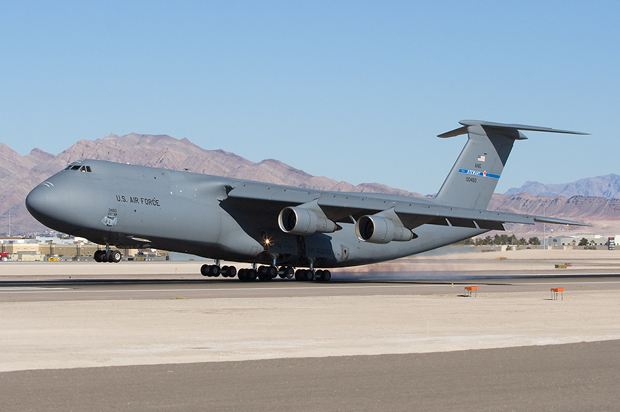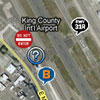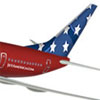| Airport use | Open to the public |
|---|---|
| Activation date | 01/1947 |
| Sectional chart | LAS VEGAS |
| Control tower | Yes |
| ARTCC | LOS ANGELES CENTER |
| FSS | RENO FLIGHT SERVICE STATION |
| NOTAMs facility | LAS (NOTAM-D service available) |
| Attendance | Continuous |
| Wind indicator | Lighted |
| Segmented circle | No |
| Lights | Dusk-Dawn |
| Beacon | White-green (lighted land airport) ROTG BCN NOT VISIBLE 115 TO 240 DEGS SE TO SW FROM ATCT. |
| Landing fee | Yes |
| Fire and rescue | ARFF index E |
| International operations | customs landing rights airport LANDING RIGHTS AIRPORT: CUSTOMS AVBL TO GA ACFT 0800-2200, ALL OTHER TIMES PPR CALL 702-261-5539. |
| Runway 7L/25R | |||||||||
|---|---|---|---|---|---|---|---|---|---|
| Dimensions | 14510 x 150 ft. / 4423 x 46 m | ||||||||
| Surface | asphalt/porous friction courses, in good condition | ||||||||
| Weight bearing capacity |
|
||||||||
| Instrument approach | Runway 7L:ILS/DME | ||||||||
| Runway 25R: ILS/DME | |||||||||
| Runway 7R/25L | |||||||||
|---|---|---|---|---|---|---|---|---|---|
| Dimensions | 10526 x 150 ft. / 3208 x 46 m | ||||||||
| Surface | asphalt/porous friction courses, in good condition | ||||||||
| Weight bearing capacity |
|
||||||||
| Runway edge lights | high intensity | ||||||||
| Instrument approach | Runway 7R: LOC/GS | ||||||||
| Runway 25L: LOC/GS | |||||||||
| Runway 1R/19L | |||||||||
|---|---|---|---|---|---|---|---|---|---|
| Dimensions | 9775 x 150 ft. / 2979 x 46 m | ||||||||
| Surface | concrete/grooved, in good condition | ||||||||
| Weight bearing capacity |
|
||||||||
| Instrument approach | Runway 1R: – | ||||||||
| Runway 19L: – | |||||||||
| Runway 1L/19R | |||||||||
|---|---|---|---|---|---|---|---|---|---|
| Dimensions | 8985 x 150 ft. / 2739 x 46 m | ||||||||
| Surface | concrete/grooved, in good condition | ||||||||
| Weight bearing capacity |
|
||||||||
| Runway edge lights | high intensity | ||||||||
| Instrument approach | Runway 1L: ILS/DME | ||||||||
| Runway 19R: ILS/DME | |||||||||
| Ownership | Publicly-owned |
|---|---|
| Owner | CLARK COUNTY P O BOX 11005 LAS VEGAS, NV 89111 Phone 702-261-5211 |
| Manager | RANDALL H. WALKER 5757 WAYNE NEWTON BLVD LAS VEGAS, NV 89119 Phone 702-261-5211 JEFF SULLIVAN (702) 261-5348. |
LAS Live Traffic |
LAS Sectional Chart |
| American aviator George Crockett, a descendant of frontiersman Davy Crockett, established Alamo Airport in 1942 on the site currently occupied by McCarran International. In 1948, Clark County purchased the airfield from Crockett to establish the Clark County Public Airport, and all commercial operations moved to the site of this airport. On December 20, 1948 the airport was renamed McCarran Field for U.S. Senator Pat McCarran, a longtime Nevada politician who authored the Civil Aeronautics Act and played a major role in developing aviation nationwide.
By this time, the airport was serving 1.5 million passengers a year, the location for the present terminals was moved from Las Vegas Boulevard South to Paradise Road, opening in March 1963. The terminal, designed by Welton Becket and Associates and John Replogle, was inspired by the TWA terminal at JFK It ultimately became the basis for the United Airlines terminal at O’Hare International Airport seven years later. In 1978, Senator Howard Cannon pushed the Airline Deregulation Act through Congress. Airlines no longer had to get the federal government’s permission to fly to a city, but instead dealt directly with airports to establish additional routes. Just after deregulation, the number of airlines serving McCarran doubled from seven to 14. An expansion plan called McCarran 2000 was adopted in 1978 and funded by a $300 million bond issue in 1982. The three-phase plan included a new central terminal; a nine-level parking facility; runway additions and expansions; additional gates; upgraded passenger assistance facilities; and a new tunnel and revamped roadways into the airport. The first phase of McCarran 2000 opened in 1985 and was completed by 1987. Between 1986 and 1997, Terminal 2 was built where two separate terminals had been in the 1970s and 1980s; one for American Airlines and the other for Pacific Southwest Airlines. In the 1990s all gates and check in counters were upgraded to use a common set of computer hardware. CUTE, Common Use Terminal Equipment. This eliminates the need for each airline to have their own equipment and allows the airport to reassign gates and counters without having to address individual airlines’ computer systems. While portions of Los Angeles International Airport and San Francisco International Airport deployed CUTE prior to McCarran, as of 2008 it remains the only major airport in the USA that is 100 percent common use. (White Plains, N.Y., is also a 100 percent common use airport, though it has only eight gates.) McCarran’s CUTE system also supports several airlines’ use of the Cockpit Access Security System, or CASS. In Europe, and to some extent the Asia-Pacific rim, CUTE has been widely prevalent for much longer. In 1998 the D Gates SE and SW wings opened adding 28 gates. The D Gates project is a modification to the original McCarran 2000 plan. On October 16, 2003, the airport installed SpeedCheck kiosks which allow customers to obtain a boarding pass without having to go to a specific airline kiosk or counter. McCarran was the first airport in the US to provide this service and the first in the world to provide the service to all airlines from a single kiosk. At the same time, 6 kiosks were activated at the Las Vegas Convention Center allowing convention attendees to get boarding passes on their way to the airport.[7] This system was enhanced to add printing of baggage tags in 2005. In 2003 the airport announced it was implementing a baggage-tracking system that will use Radio-frequency identification (RFID) bag tags from Matrics Inc. to improve air safety. The decision to implement the tracking system makes McCarran one of the first airports to use the RFID technology airportwide. On January 4, 2005, the airport started offering wireless internet service at no charge. The signal is available in the boarding areas and most other public areas. The airport was the first to provide this as a free service for the entire facility[citation needed]. At the time, this was the largest (2 million square feet (180,000 m²)) free wireless Internet installation in the world. In 2005, the D Gates NE wing opened adding 10 gates. On April 4, 2007, the Consolidated Rent-a-Car facility, located 3 miles (5 km) from the terminals, opened with 5,000 parking spaces on 68 acres (280,000 m2) of land. A fleet of 40 buses provides transportation from the terminals to the facility which houses 11 car rental companies. Advantage, Savmore, Payless, and Enterprise will use a new access control system. This system will be based on bar codes. Due to Continental Airlines moving into the Star Alliance, along with cost-cutting moves at US Airways because of the 2008 night-flight hub closure, the US Airways Club was closed on September 13, 2009. All passengers flying on US Airways or United Airlines can access the Presidents Club in Concourse D starting on October 25. |









